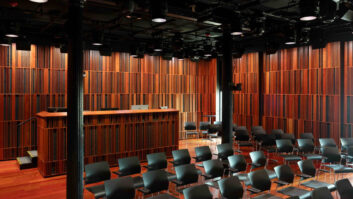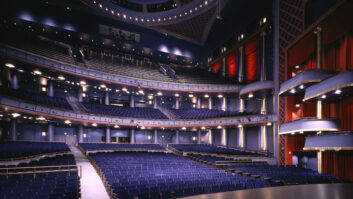Where Do We Go from Here?
May 1, 2003 12:00 PM,
PETER H. PUTMAN, CTS
As the pro A/V industry sets its sights on InfoComm 2003 in Orlando, Florida (June 2 through 5), there are plenty of questions to be answered and hot topics to be debated. The sluggish economy and some pretty brutal price wars in the projector and monitor segments have many dealers and end-users wondering when and what they should buy.
LCD projectors are plummeting to all-time low prices, and small increases in brightness and decreases in weight continue to be announced. DLP projectors still command a price premium, but even those products are feeling the pressure of commodity pricing. There has even been an attempt to justify the higher cost of DLP-engined projectors with a study that purports to show a rapid degradation in LCD projector image quality.
As projector manufacturers look for new markets to conquer, the home theater and educational channels look particularly attractive. But the former is a small channel, and the latter is price sensitive. Lower-cost business projectors are now being sold against higher-priced home-theater models in the same channel, and given the small image-quality differences, it is proving to be a real fight.
The flat-screen market isn’t any less confusing. So many companies have jumped into the ring to sell OEM products that it’s hard to determine which company actually makes which products. Because of overcapacity of plasma production lines in Japan and Korea, smaller resellers are making aggressive deals to buy production line capacity a month at a time. The result is deep price cuts, which are turning the plasma market on its head.
Now there’s a wild card, as Sharp, Samsung, and LG Philips get ready to launch a line of TFT LCD monitors and integrated TVs in 40-, 42-, 46-, 52-, and 54-inch sizes with even higher resolutions than plasma. Although these monitors still command a price premium over plasma, that gap is expected to close quickly in 2003. Which technology will win out? Some think that LCDs will dominate the market up to 42 inches, with plasma holding sway above that. But for how long?
STATE OF FLUX
Signal distribution continues to be a puzzler. For years video and audio have been moved around with different varieties of coaxial and balanced lines. A few years back, some enterprising companies started RF-modulating these signals and transmitting them over untwisted-pair (UTP) Cat-5/6 wiring, a solution that works up to about 300 feet. Several players in this market continue to roll out new UTP transmitter, receiver, and hub products.
But other transmission modes are viable. One company continues to proclaim the advantages of fiber-optic distribution, and a handful of large Asian manufacturers have been beating the drum for IP distribution of digital packets over LANs. Which system will win out? It’s still too soon to tell, although the table is already stacked in favor of IP, given the widespread use of LANs.
One thing is for certain: there will continue to be aggressive price cutting as manufacturers try to kick start the market. When portable LCD projectors first appeared in 1994, they took the world by storm and were largely responsible for the unprecedented growth of the pro A/V market these past nine years.
Keep your eyes open for more low-price front projectors. Although NEC’s VT460 is available for less than $1,000, that’s a subsidized manufacturer price. You will likely see some true-blue, sub-$1,000 boxes with SVGA resolution and more than one XGA model with a list price less than $2,000. There’s still a scarcity of three-chip DLP imaging in the $20,000 to $30,000 range, so look for Panasonic’s PT-D7500U and PT-D7600U to have new neighbors at the show.
What will the next big thing be? Cheaper plasma? LCoS? IP connectivity? LCD displays? One trend that has already been seen in 2002 is the “we’ll sell anything” attitude among companies that once operated exclusively in the projector marketplace. Everyone has a plasma monitor now. Everyone has a projector. Good luck in sorting out their parentage!
BRAND SPANKIN’ NEW
Here is a sampling of the new products you’ll see on the show floor in Orlando.
Christie has announced the DS30, a 6.6-pound single-chip front DLP projector. It uses a 1,280-by-1,024 DMD, is rated at 3,000 lumens, and is supposed to have a noise level of only 28 dB. At the high end, Christie will show the RoadRunner LX100 and LX65 DLP projectors. Both XGA (1,024 by 768) resolution models are rated at 10,000 and 6,500 lumens, respectively.
Barco has several tricks up its sleeve. The iQ G500 LCD projector uses three 1.4-inch polysilicon LCD panels and is rated at 5,000 lumens. Advanced picture-in-picture (PiP), seamless source switching, and dual-lamp design for improved reliability are included on the projector. The iQ Pro G500 goes one step further with a computer server integrated in the projector design. Barco’s SLM Executive Series gets two new models, the 10,000-lumens G10 and R10. Both have PiP, a LAN connection, and seamless scaler/mixers. In the big-screen area, look for the new SLite LED display with 10 mm and 14 mm pitch versions and hot-swap capability.
Sony is pushing ahead with networked projectors and digital signage. Check out the VPL-PX35, a 2,600-lumens XGA (1,024 by 768) projector with network compatibility, 90-degree tilt capability, and a power direct on/off feature. There’s also the VPL-FX51, a brighter (5,200 lumens) IP-compatible installation design with Windows CE onboard. It uploads and displays a variety of image formats directly, including PPT and BMP files.
Sony will also officially roll out PJNet networked projector software. This program monitors as many as 255 projectors simultaneously, schedules on and off events for groups of projectors, provides remote diagnostics and monitoring, and reports lamp hours. To round out the picture, Sony will also introduce two new TFT LCD monitors for video production, the 17-inch viewable LMD-170 and the 23-inch viewable LMD-230. Both have controls and operating interfaces similar to Sony’s BVM series monitors.
In addition to the groundbreaking VT460, VT60, and VT660 portable LCD projectors, NEC Technologies will have some new high-brightness LCD boxes out for view. The GT5000 offers XGA (1,024 by 768) resolution, whereas the GT6000 is an SXGA (1,280 by 1,024) design. Both projectors have a dual-lamp system and are rated at 3,000 lumens in single-lamp mode and 6,000 lumens with both lamps on. NEC’s SweetVision deinterlacing and Faroudja DCDi processing are standard on both models.
Canon plans to unveil the LV-5200, a 9-pound desktop/installation LCD projector rated at 1,700 lumens. It provides SVGA (800 by 600) resolution with intelligent scaling and includes a DVI-I interface, a 1.5x motorized zoom lens, and a 34 dB fan. Epson will showcase the PowerLite 735, which tips the scales at 4.4 pounds and combines 802.11b wireless capability with XGA (1,024 by 768) resolution and 2,000 lumens of brightness.
Lately, Hitachi has been on a weight-reduction program. Look for the CP-S210W, a 6.6-pound SVGA (800 by 600) LCD projector that is specified at 600 lumens. It offers vertical keystone correction and multiple connector options. Dukane‘s ImagePro 7100HC is an SVGA DLP projector that weighs less than 7 pounds. It is rated at 1,000 lumens with SVGA (800 by 600) resolution, HDTV compatibility, Faroudja DCDi video processing, and simple setup with color-coded connections.
Toshiba has its own “mini” with the TDP-D1, an ultrabright DLP projector weighing in at 5.3 pounds. The TDP-D1 is rated at 2,000 lumens and has XGA (1,024 by 768) native resolution and automatic keystone correction. In addition, Toshiba’s TLP-T720/T721 series projectors combine XGA (1,024 by 768) resolution, 2,400-lumens brightness, and a built-in PCMCIA memory card slot with WiFi 802.11b interfaces. The 7.5-pound TLP-T720 is a standalone projector, and the TLP-T721 incorporates a built-in video copy stand.
Optoma is an up-and-coming player in the projector market and will have three new offerings. The EzPro 725 is a single-chip DLP model with 1,100 lumens, XGA (1,024 by 768) resolution, a somewhat long 1.8:2.1 zoom ratio, and HDTV compatibility. Its companion, the EzPro 731, uses an SVGA (800 by 600) DMD and is also rated at 1,100 lumens, and the H76 is a home-theater projector with 1,280-by-720, 16:9 DMDs. It cranks out 1,000 lumens, weighs 16.5 pounds, and comes with mechanical and digital lens shift.
Mitsubishi will display the XD350U ColorView DLP projector. It is rated at 2,500 ANSI lumens in a 6-pound package, provides XGA (1,024 by 768) resolution, and features horizontal and vertical keystone correction. Its universal-learning remote can be programmed to operate two additional video sources such as a DVD player or VCR.
Aimed at the education market, the XL5950 ColorView LCD projector has a built-in motion-sensitive antitheft alarm. It also has horizontal and vertical lens shift and 3D CineView, a proprietary video processor. Both projectors are compatible with Mitsubishi’s ProjectorView networking system, which connects its projectors through an external serial-to-Ethernet translator (for a review of ProjectorView, go to p. 90).
At the Sharp booth, you’ll see the Notevision PG-A10X, which offers 1,300 ANSI lumens brightness and native XGA (1,024 by 768) resolution, as well as the SVGA-resolution PG-A10S (1,500 ANSI lumens). Both models are part of a new line of no-frills “value” projectors. The 6.4-pound PG-A10X is suitable for installation and portable use, is HDTV compatible, and also offers a network connection through its RS-232 input.
In the flat-screen world, V Inc. will show off the Vizio P1, an integrated 32-inch plasma TV. It has a pixel resolution of 852 by 1,024 and supports a wide range of PC and video formats, including 480p, 720p, and 1,080i. Samsung will feature its 42-inch PPM42S2 (852 by 480), 50-inch PPM50H2 (1,366 by 768), and 63-inch PPM63H1 (1,366 by 768) plasma monitors, as well as the new 40-inch 403T LCD monitor (1,280 by 768) that uses Samsung’s PVA LC alignment process for better contrast.
Fujitsu will be showcasing three recently introduced wide-screen (16:9) Plasmavision SlimScreen monitors for the commercial market. The 50-inch P50XCA11 (1,366 by 768), the 42-inch P42HCA11 (1,024 by 1,024), and the 42-inch P42VCA21 (852 by 480) are completely redesigned from previous models, and all three incorporate Fujitsu’s exclusive Advanced Video Movement digital video processor. Each monitor includes two sets of analog RGB inputs (15-pin and BNC) and an expansion slot to accept an optional video card for additional connectivity.
TV One has several new rackmount LCD video monitors. The LM-404R Quad contains four LCDs, each with 4-inch diagonal viewing areas. The LM-563R Triple contains three LCDs, each with 5.6-inch diagonal viewing areas. The LM-682R Dual contains two LCDs, each with 6.8-inch diagonal viewing areas. These dual-input monitors accept composite video and S-video signals.
In addition, TV One’s LM-1501 has a 15-inch diagonal viewing area, and the LM-1701 has a 17-inch diagonal viewing area. These monitors accept composite video, S-video, stereo audio, and PC signals. The LM-1501 handles resolutions up to XGA, and the LM-1701 handles resolutions up to SXGA.
There is lots of news from the interfacing world. Kramer‘s KPro Elite line of matrix switchers consists of the VP-88xl, VP-128xl, VP-168xl, and VP-1616xl. These models offer Matrix Mapping, whereby individual R, G, B, H, V, and audio left and right channels can be switched independently for flexible expansion. Kramer’s Room Grouping function lets each switcher be configured to as many as four individual switchers in one box, and an RGB Delay feature permits the sync to precede the video for cleaner signal switching.
Kramer will also showcase the value-priced VP-720DS and VP-723DS scalers. These interfaces are true multistandard video-to-RGBHV scalers that convert video, S-video, component video, VGA through UXGA, and DVI signals to multiple user-selectable output pixel rates. They also allow fade-to-black switching between inputs.
TV One will introduce the C2-770 universal video scaler, which handles any resolution up to 2,048 by 2,048. The C2-770 is also a worldwide standards converter, chromakeyer, lumakeyer, aspect ratio converter, and time base corrector with genlock. You’ll also find the Image Matrix 400 series matrix routing switchers, available in a variety of matrix sizes from 8 inputs by 8 outputs to 16 inputs by 16 outputs, with 400 MHz bandwidth to support RGBHV formats at resolutions up to 2,100 by 1,600, and YPbPr formats in all HDTV resolutions.
Extron‘s VSC 900 and VSC 900D video scan converters offer proprietary scan-converting technologies for sharper, crisper images. Both of the models convert high-resolution computer images from up to 1,600 by 1,200 down to video rates such as composite video, S-video, component video, and RGB video; the VSC 900D also outputs serial digital interface digital video. In addition, both models have genlock to external black-burst signals and RGB level attenuation.
For those hideaway installations, Extron’s HSA 822 is a vertically lifting, architectural interface panel. The HSA 822 enclosure fits nearly flush to the table surface, keeping A/V and interface connectors out of sight. Pressing down on the enclosure’s top releases a mechanical latch, letting the HSA 822 rise vertically from the installation surface and present the connectors at a 90-degree angle to the tabletop.
Communications Specialties (CSI) is big on fiber-optic signal distribution for video and audio. Its Pure Digital Fiberlink Flex system is a custom-configurable fiber-optic link that can transmit one channel of video in one or two directions, four independent audio channels in one direction or two in each direction, and two channels of bidirectional data. The Flex System is available in card and box versions and works with single-mode or multimode fiber, operating at wavelengths of 850, 1,310, or 1,550 nanometers.
CSI’s Pure Digital Fiberlink 7070 system supports all formats of component video, including YPbPr, YCbCr, YUV, and Y/R-Y/B-Y, along with two independent channels of audio over one single-mode or multimode fiber. The system features 14 MHz bandwidth luminance and 7 MHz chrominance bandwidth, and the two line-level audio channels on the 7070 Series may be user-configured to have balanced or unbalanced inputs and outputs.
U.K.-based Electrosonic is showing two new video processors for use in corporate communications and control and command applications. Director is a network-enabled display processor that can access, manage, control, and display multimedia information sources. It also provides the link between audiovisual equipment, IT equipment, and content management.
Vision Network is specifically designed for environments that are heavily integrated with a networked infrastructure, such as traffic management, the military, and network operating centers. Information can be presented directly from networked devices, and system control can be initiated from multiple locations across a network. A Windows 2000 operating platform allows for easy integration with existing and custom software applications.
Aurora Multimedia‘s TVP-1000+ plug-in video scaler and the external XTune+ version have dual NTSC tuners, dual S-video and composite inputs, and DVI-I interfaces. In addition, the TVP-1000+ has DVI-HDCP. Both versions can combine two SDTV sources with PiP.
RGB Spectrum‘s RGB/Videolink 1690-1U and 1690D1-1U scan converters are now available in a single-rack-unit configuration. These converters accept interlaced or noninterlaced RGB inputs from virtually any workstation or desktop computer and synchronize to signals with screen resolutions up to 1,600-by-1,280 pixels. NTSC/PAL composite video, S-video, and component analog video outputs are standard, and SMPTE 259M digital output is available as an option.
The DGx 102 dual-channel recording system captures, compresses, stores, and plays back imagery at up to 1,600-by-1,200-pixel resolution and can record multiple signal types simultaneously, including computer, radar, video, sonar, FLIR, and x-ray signals, as well as audio. Recordings are time stamped and may be event marked for random access. The Model 102 offers high-capacity digital tape and digital disk storage options, and a DSS option provides 9- or 15-hour recording capacity on removable hard drives.
Peter H. Putman owns PHP Communications, in Doylestown, Pennsylvania. The author of The Toastmasters Guide to Audio/Visual Presentations, Putman is also a regular columnist in S&VC.










